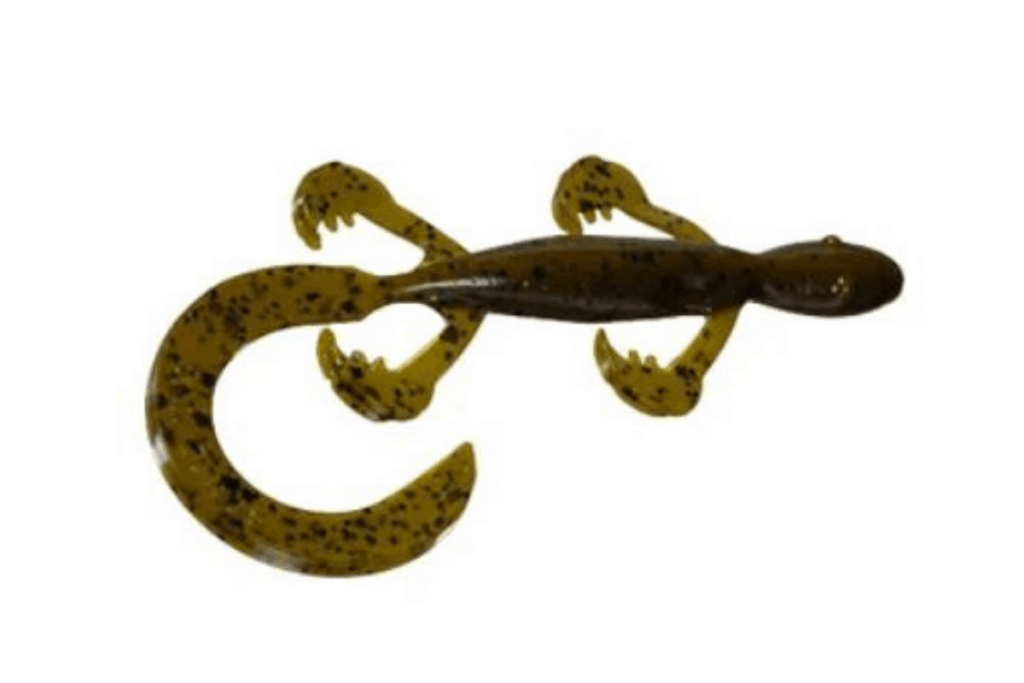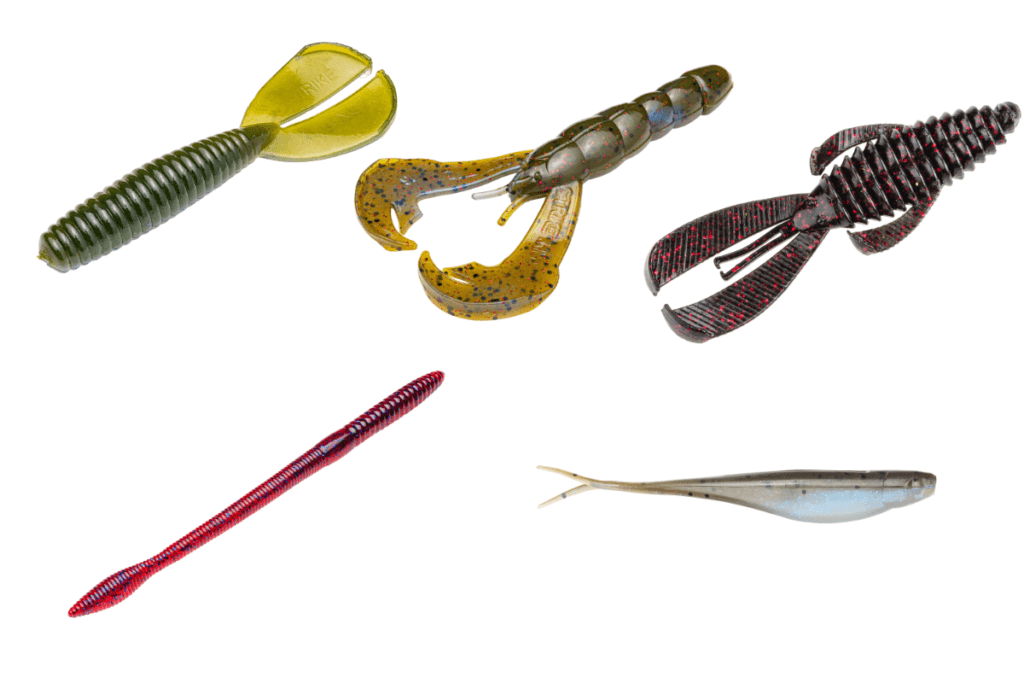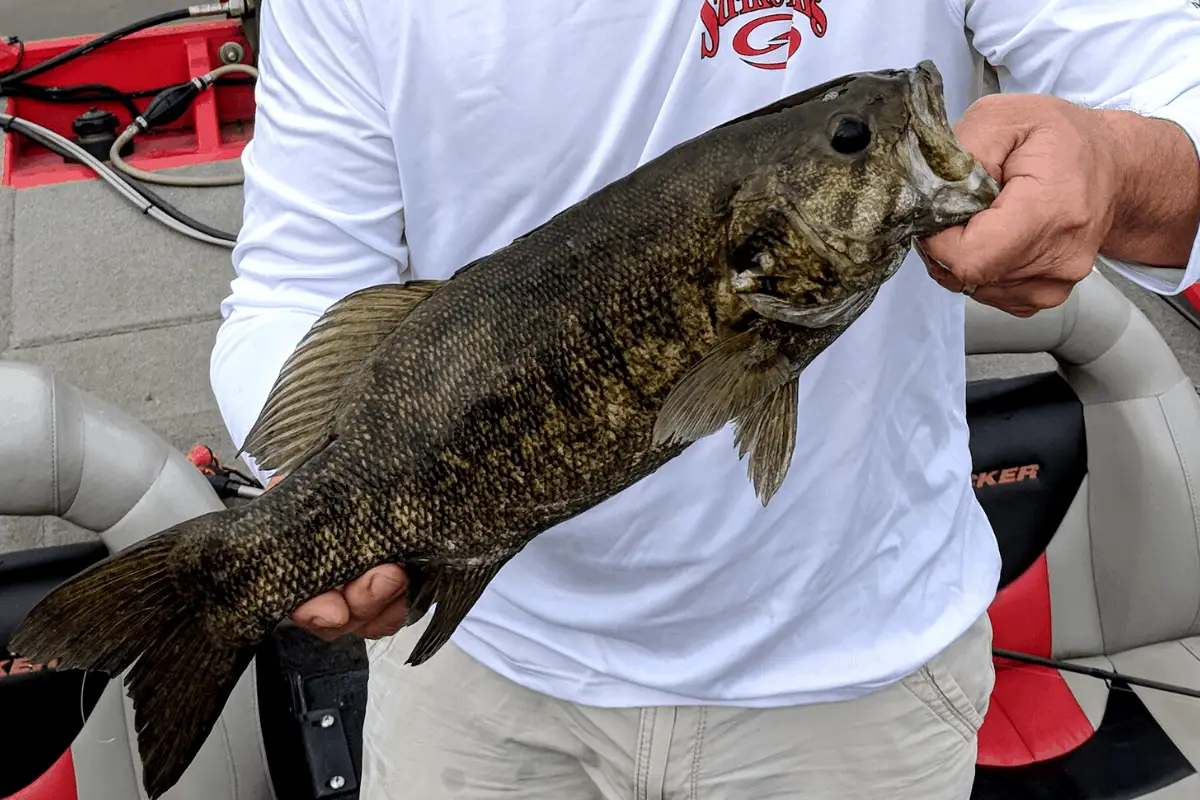This highly effective tactic has been around for decades. It is a great rig for both finding a catching numbers of bass. It also allows for a variety of baits to be presented across bottom structure.
A Carolina Rig consists of a heavy weight, plastic bead, barrel swivel, and some leader. It is designed to be dragged across the bottom of a lake or river. The trailing soft plastic lure appears to “scoot” across the structure and is appealing to all kinds of bass looking for an easy meal.
In this article, we will break down a traditional Carolina Rig setup as well as some effective ways to fish it based on the conditions that you have on your home waters.
What Is a Carolina Rig?
The Carolina Rig is an effective way to present soft plastic lures across bottom structure in both shallow and deep water.
The actual rig uses a heavy weight, anywhere from ½ ounce to 1 ounce in size, a plastic bead, a barrel swivel, and then some leader.
History
No one knows the exact origin and detailed history of the rig, but the most common theory is that panfish and catfish anglers developed this method as a means to present live bait in deeper water. Of course, most people believe that its practice grew out of South Carolina, specifically the Santee Cooper region.
The method gained notoriety in 1985 when Jack Chancellor won the Bassmaster Classic using this method.
In an article on Bassmaster.com, Chancellor said, “Before then there was hardly anyone who did the Carolina rig, so I take pride in having a little bit to do with that.”
To be cliche, the rest is history.
Recent Use
Fishing trends come-and-go. The Carolina Rig is something that is still used, but not nearly as often as it was even twenty years ago.
In the past, most boat decks would have a specialized rod rigged with one all the time. Many anglers even made pre-rigged leaders and would wrap them around a foam board to make retying quick in the middle of a fishing trip.
This drop in angler interest can be a huge plus for bass enthusiasts today who want to present something differently than others on the water.
Best Time to Fish a Carolina Rig
By-far-and-away, I have the best luck with a Carolina Rig when the barometric pressure is higher. The reason is quite simple.
On a higher pressure day, the microorganisms in the water column are pushed down to the bottom of the lake or river bed. This includes such creatures as zooplankton. When this happens, the smaller baitfish and minnows are more apt to be down. When the baitfish are hugging the bottom, that is where the predators will be as well.
I have used the Carolina Rig with success on low pressure, cloudy days, but I usually prefer a different horizontally moving bait when the weather is like that.
Equipment and How to Rig
The rod is a critical component to fishing this rig properly. The heavy weight and amount of leader can make this setup cumbersome to cast.
I love to use a rod that is at least 7’, preferably something in the 7’6” range. A medium-heavy power rating has enough backbone to move a lot of line quickly, yet still has enough tip to move the lure along the bottom properly
As far as the reel, most any gear ratio will work just fine, but I prefer a high speed baitcaster. As I mention below, the fish will often run at the boat and a high speed reel will help you catch up to them.
Mainline
I spool up the reel with heavy mainline. I have used 20lb monofilament to 50lb braid. I prefer the braid since it is easy to handle at larger test ratings than the bulkier diameter of mono.
The Rigging
Once you have your mainline spooled, slip a heavy sinker onto the line. I almost always use a ½ ounce egg sinker. The shape of the egg sinker keeps it from getting hung too bad. A traditional worm weight, or bullet weight, with the very conical nose wedges its way into rocks at these heavier weights and gets stuck a lot.
After the sinker, slide a plastic faceted bead up the line and then tie on a barrel swivel. Red seems to be the traditional bead color, but I prefer black myself.
The bead is there to protect the knot from the heavy weight pounding on it. Most craft sections of big box stores have these beads and you can buy hundreds of them for just a few dollars. A plastic bead is less apt to chip than glass and will fray your line less.
Leader
Ninety percent of the time, my leader is going to be 10lb fluorocarbon, although I will occasionally use monofilament. As far as length, this is determined by the clarity of the water you are fishing.
If there is a heavy stain to the water, a leader of 18” will suffice. On my home lake, where the water is ultra clear, I will often use a leader that is 4’ in length – even longer sometimes.
The length of the leader is also reliant upon the type of structure and cover you have. If the bottom of the lake or river is fairly smooth with small rock or gravel, a short leader works great.
The more diverse, or large, the rocks are dictates a longer leader will come through them better. If the water you are fishing has vegetation, I also like a longer leader.

Lures for Carolina Rigging
This is why I love a Carolina Rig. You can use any soft plastic you can think of. Experiment to find what you prefer.
Myself, I am a huge fan of small creature baits. My favorite is a Strike King Wild Thang Jr. Unfortunately, this lure has since been discontinued, but there are many similar creature baits on the market.
Besides the creature bait, I have used traditional do-nothing lures, like a centipede or french fry, lizards, big ribbontail worms, soft jerkbaits, and plastic craws.
Rig the bait of your choice Texas style with the appropriate sized hook.
Common Misconception
You will hear many people say that a Carolina Rig floats the lure off the bottom. I find this to be inaccurate. (See video above.) I prefer to say that the Carolina Rig effectively drags, or scoots, the lure across the bottom.
The one exception to this is if you use the Elaztech plastic. Zman and Strike King have lures made with this material. If you want a lure that will truly float off the bottom on a Carolina Rig, then make sure you have something made from this type of plastic. In fact, the last lure in the video above shows how much better an Elaztech lure floats.

The Presentation
The Dragging Method
This is my favorite. Cast the rig out, let it sink, and then use the rod to drag the lure back. A side sweep of the rod is the only action that is needed. Then reel up the slack line and repeat with another side sweep.
Be careful though, a rod over the 7ft mark will move a lot of line quickly when you side sweep it. Use the rod to slowly move the bait. Visualize the lure scooting across the bottom, like a crawdad scurrying along, and you will pace it correctly. If you sweep too quickly, you may still get bites, but not nearly as many when the lure is moved at a more natural pace.
The Popping Method
If the dragging method is not working for me, I will change the rod from a side sweep position to a vertical position straight in front of me. I will then pop the rod from 9 o’clock to 12 o’clock. This will pop the weight off the bottom and bring it forward. The bait will hop as well, but with a more subtle action.
Like I mentioned earlier, I only use this presentation when the drag method is not working. Setting the hook with this type of presentation is much more difficult.
The Hookset
When using the side sweep dragging method, your rod is always in a great hookset position. When you feel some weight, or a bump, just set the hook the same direction you are already moving the lure.
You will want to use a fairly aggressive hookset. There is a lot of line out in the water that needs to transfer energy directly to the hook. That is why I love to use lightwire hooks when Carolina Rig fishing. They will penetrate the fish’s lip easier with that much line out.
Be Ready
For some reason, when I Carolina Rig fish, the bass will often run straight at the boat. Be ready for this and reel up the slack quickly if needed. This is where a high gear ratio reel comes in handy.
Also, make sure to set the hook anytime something feels “different.” A Carolina Rig is one of those presentations where a bass is apt to swallow the lure if they have it for too long. I much rather set the hook more than I need too, than harm the fish.
Final Thoughts
The Carolina Rig catches fish. Period. I have had some of my best days on the water with this technique.
It is an excellent follow-up presentation after you have worked through a school with another lure, like a crankbait. It will often get those fish fired up again.
This presentation is also a great way to locate fish on a new body of water. However, like I mentioned earlier in the article, this rig works best on days when the barometric pressure is higher and the lowest organisms on the food chain are pushed to the bottom of the lake or river bed.
Good luck with the Carolina Rig and let me know how it goes!
Tight lines and be safe.

